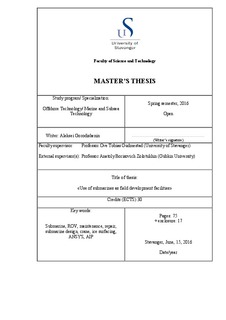| dc.description.abstract | Today, it becomes clearer that the era of easy to extract oil is almost gone. Thus, the oil and gas industry starts to face the development of complex deposits located in deep and ultra-deep waters or in the Arctic region, often under the ice. This thesis has focused on the second type. So, it is necessary to find the most effective solutions for the field development in the ice infested waters where the ice-free is short. One of the possible answers can be the transfer of different technologies from other industries.
Such kind of technology may be taken from the military industry. Of course, we are talking about submarines. This thesis considers submarines and their possibilities as solutions for challenges in the Arctic environment. Nowadays, diesel-Stirling-electric submarines do their job in a way with minimum risks to the operator, the environment, and the crew.
The main idea of this paper is to show that submarines can be used as a mothership or, in simple words, a carrier for ROVs, which application is very versatile, but the core purpose is to maintain the field operations during the production phase. To show that it is possible, the design of submarines will be considered with an accent on special room for ROVs and the compartment for its running in the water. Nevertheless, submarines can perform simple tasks like installation, inspection, maintenance, and repair by itself with a help of an on-board gantry crane. Risk analysis will also be included to prove that the idea of submarine utilization is safe for everyone.
The ice surfacing is included in the analysis. The design of the submarine is performed so that it has a sail. In a case when the submarine breaks the surface, initially ice breaks at the point of the contact of a sail with the bottom layer of ice and as a consequence, stress will be created at the point of the contact, and then the ice will break due to bending.
For changing the crew of the submarine, it is sufficient that the submarine ascends so that the sail is on the ice, and not necessarily that the submarine breaks the surface completely. It is important to remember that a submarine cannot break too thick ice because capabilities of the submarine are limited. To solve this problem a special equipment is installed on the submarine like an ice profiling sonar. The sonar searches the ice for a thickness the submarine could break in a place where the crew landing is required. Usually, it is the ice with a thickness not exceeding 1,5 meters although. It depends on the size, mass, and geometry of the submarine. | nb_NO |

